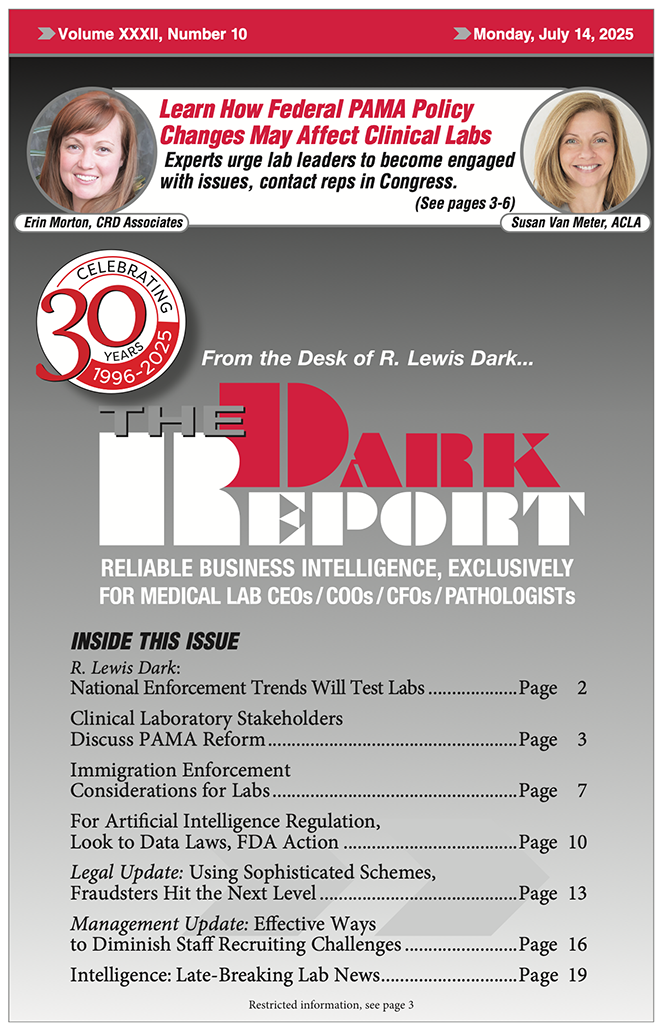Laboratory Management
Laboratory management in today’s clinical lab industry is changing rapidly and facing entirely new challenges. One problem is the lack of upcoming younger lab managers, as the retirements of baby boomer pathologists, medical technologists and lab scientists are in the near future. These individuals make up the largest proportion of supervisors, managers, and lab administrators working in labs today.
As they retire, every clinical lab and pathology group needs to have the next generation of leaders ready to step up and assume responsibilities. But, across the lab industry, there are limited opportunities for every lab’s brightest up-and-comers to get the regular management development opportunities that are common among Fortune 500 companies. The Dark Intelligence Group has called for the establishment of a mentoring program to help overcome this problem.
At the same time, downward pressure on reimbursements and mounting competition have created an environment that requires much more effort for a medical lab to grow and thrive.
Legislation, including the Health Information Technology for Economic and Clinical Health Act (HITECH) of 2009 and the Patient Protection and Affordable Care Act (PPACA) of 2010, have placed significant demands on medical laboratories and healthcare providers to improve internal efficiency even while offering more services for less money. This pressure to “do more with less” is further compounded by the need to deliver increasingly personalized client service to retain and win clients.
With the era of fee-for-service medicine coming to a close, every clinical laboratory and anatomic pathology organization needs a strategy for getting paid, as new reimbursement models that support patient-centric care will make up a larger portion of lab revenues.
The challenge for every clinical laboratory manager is to understand how to evolve from a business model that is accession-centric or volume-centric to one that is patient-centric.
Many clinical laboratories today are developing data repositories to logically link all transactional and other information about a patient. These repositories allow physicians to see all relevant information, identify trends, and provide better care as a result, enabling labs to provide greater value to their customers, patients and payers, thus creating more value and becoming more patient-centric.
THE DARK REPORT Honors Lab “Movers & Shakers”
By Robert Michel | From the Volume XXVI No. 12 – September 3, 2019 Issue
CEO SUMMARY: It’s time again to recognize and honor the lab industry’s strong leaders in innovative management. These laboratory executives are implementing business strategies designed to position their lab organizations to serve the changing needs of the healthcare system. Their vis…
Specialty Labs and Dynacare Have Balance Sheet Differences
By Robert Michel | From the Volume XXVI No. 12 – September 3, 2019 Issue
SINCE LAST FALL’S SUCCESSFUL IPOs (initial public offering) raised $92 million for Specialty Laboratories, Inc. and $50 million for Dynacare, Inc., the financial fortunes of the two lab companies have begun moving in different directions. Lab administrators and pa…
LabNet of Ohio Profits From Network Projects
By Robert Michel | From the Volume XXVI No. 12 – September 3, 2019 Issue
CEO SUMMARY: Since its inception seven years ago, this regional lab network has worked diligently to create the service infrastructure necessary to pursue managed care contracts. Along the way, LabNet of Ohio has found gold in such business initiatives as shared testing and group purchasi…
Market Changes Lead LabCorp To Follow New Strategic Direction
By Robert Michel | From the Volume XXVI No. 12 – September 3, 2019 Issue
CEO SUMMARY: When formed in 1995, Laboratory Corporation of America faced a financially-hostile marketplace for lab testing services. However, strategic planning retreats in 1997 and 1999 were pivotal in redirecting this billion-dollar lab behemoth toward financial stability. During 2000,…
Controversial Montana Ruling Pits Nurses Against Labs
By Robert Michel | From the Volume XXVI No. 12 – September 3, 2019 Issue
MONTANA IS IN THE MIDST of an interesting feud over the scope of practice between nurses and certified laboratory professionals. On December 11, 2000, the Montana Board of Nursing issued a declaratory ruling stating that the scope of practice for nurses included performing unwaived …
Nurse Shortage Parallels That of Fewer Med Techs
By Robert Michel | From the Volume XXVI No. 12 – September 3, 2019 Issue
CEO SUMMARY: It’s a story that will soon become a national headline. Even as laboratories struggle to find enough med techs to fill open positions, hospitals are facing an even bigger problem in getting enough nurses to keep units staffed and open. Recruiting nurses overseas is one solu…
Lab Sales & Marketing Programs Are Changing
By Robert Michel | From the Volume XXVI No. 12 – September 3, 2019 Issue
CEO SUMMARY: Market evidence points to a shifting role in the sales priorities of the national labs. Meanwhile, regional laboratories and pathology companies are enjoying surprising success with their sales and marketing programs. These shifting patterns may indicate a new stratification …
Two Labs Complete IPOs, AML May be Next in Line
By Robert Michel | From the Volume XXVI No. 12 – September 3, 2019 Issue
CEO SUMMARY: During the year 2000, investors liked the performance of clinical labs. When stock market woes surfaced this fall, it was not enough to dampen investor interest in Dynacare and Specialty Laboratories. Both companies funded their initial public stock offering in a difficult ma…
Dynacare’s Business Plan Includes New Direction
By Robert Michel | From the Volume XXVI No. 12 – September 3, 2019 Issue
CEO SUMMARY: Look for Dynacare, Inc. to undergo a significant transformation. Although it will not abandon its efforts to partner with hospital laboratories, Dynacare has made a renewed commitment to expand and market itself as a provider of esoteric and reference testing. These changes a…
DARK REPORT Presents “White Paper” Summary Of Laboratory Industry
By Robert Michel | From the Volume XXVI No. 12 – September 3, 2019 Issue
INTRODUCTION: To celebrate five eventful years of service to the laboratory industry and pathology profession, THE DARK REPORT is pleased to present its first “White Paper” on the laboratory industry. Our goal is help laboratories and their suppliers accurately identify relevant market dynami…
CURRENT ISSUE

Volume XXXII, No. 10 – July 14, 2025
This issue is strong on different flavors of enforcement that clinical laboratories, whether they want to or not, will need to contend with. Lab stakeholders provide insights that medical labs need to brace for more action to counter pending test reimbursement rate cuts under PAMA. Also, this issue provides the legal and regulatory landscape for clinical labs’ use of AI and how it evolves with the technology. AI is creating legal uncertainty for clinical labs, especially around data privacy and FDA oversight of AI tools in diagnostics.
See the full table of contentsHow Much Laboratory Business Intelligence Have You Missed?
Lab leaders rely on THE DARK REPORT for actionable intelligence on important developments in the business of laboratory testing. Maximize the money you make-and the money you keep! Best of all, it is released every three weeks!
Sign up for TDR Insider
Join the Dark Intelligence Group FREE and get TDR Insider FREE!
Never miss a single update on the issues that matter to you and your business.
Topics
- Anatomic Pathology
- Clinical Chemistry
- Clinical Laboratory
- Clinical Laboratory Trends
- Digital Pathology
- Genetic Testing
- In Vitro Diagnostics
- IVD/Lab Informatics
- Lab Intelligence
- Lab Marketplace
- Lab Risk & Compliance
- Laboratory Automation
- Laboratory Billing
- Laboratory Compliance
- Laboratory Equipment
- Laboratory Information Systems
- Laboratory Management
- Lean Six Sigma
- Managed Care Contracts
- Molecular Diagnostics
- Pathology Trends
- People
- Uncategorized

